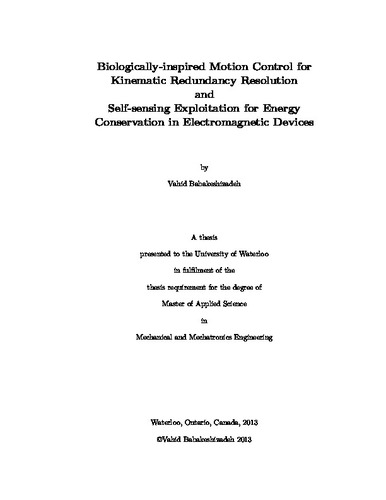| dc.contributor.author | Babakeshizadeh, Vahid | |
| dc.date.accessioned | 2014-01-07 17:59:28 (GMT) | |
| dc.date.available | 2014-01-07 17:59:28 (GMT) | |
| dc.date.issued | 2014-01-07 | |
| dc.date.submitted | 2014 | |
| dc.identifier.uri | http://hdl.handle.net/10012/8123 | |
| dc.description.abstract | This thesis investigates particular topics in advanced motion control of two distinct
mechanical systems: human-like motion control of redundant robot manipulators
and advanced sensing and control for energy-efficient operation of electromagnetic
devices.
Control of robot manipulators for human-like motions has been one of challenging
topics in robot control for over half a century. The first part of this thesis
considers methods that exploits robot manipulators’ degrees of freedom for such
purposes. Jacobian transpose control law is investigated as one of the well-known
controllers and sufficient conditions for its universal convergence are derived by
using concepts of “stability on a manifold” and “transferability to a sub-manifold”.
Firstly, a modification on this method is proposed to enhance the rectilinear trajectory
of the robot end-effector. Secondly, an abridged Jacobian controller is
proposed that exploits passive control of joints to reduce the attended degrees of
freedom of the system. Finally, the application of minimally-attended controller
for human-like motion is introduced.
Electromagnetic (EM) access control systems are one of growing electronic systems
which are used in applications where conventional mechanical locks may not
guarantee the expected safety of the peripheral doors of buildings. In the second
part of this thesis, an intelligent EM unit is introduced which recruits the selfsensing
capability of the original EM block for detection purposes. The proposed
EM device optimizes its energy consumption through a control strategy which
regulates the supply to the system upon detection of any eminent disturbance.
Therefore, it draws a very small current when the full power is not needed. The
performance of the proposed control strategy was evaluated based on a standard
safety requirement for EM locking mechanisms. For a particular EM model, the
proposed method is verified to realize a 75% reduction in the power consumption. | en |
| dc.language.iso | en | en |
| dc.publisher | University of Waterloo | en |
| dc.subject | Redundant Manipulator | en |
| dc.subject | Jacobian Transpose Controller | en |
| dc.subject | Under-actuation | en |
| dc.subject | Minimum Attention | en |
| dc.subject | Electromagnetic Devices | en |
| dc.subject | Energy Conservation | en |
| dc.subject | Self Sensing | en |
| dc.subject | Generalized Likelihood Ratio Test | en |
| dc.title | Biologically-inspired Motion Control for Kinematic Redundancy Resolution and Self-sensing Exploitation for Energy Conservation in Electromagnetic Devices | en |
| dc.type | Master Thesis | en |
| dc.pending | false | |
| dc.subject.program | Mechanical Engineering | en |
| uws-etd.degree.department | Mechanical and Mechatronics Engineering | en |
| uws-etd.degree | Master of Science | en |
| uws.typeOfResource | Text | en |
| uws.peerReviewStatus | Unreviewed | en |
| uws.scholarLevel | Graduate | en |

